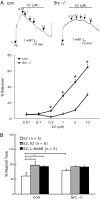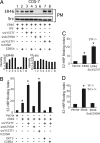Variant estrogen receptor-c-Src molecular interdependence and c-Src structural requirements for endothelial NO synthase activation
- PMID: 17921256
- PMCID: PMC2034248
- DOI: 10.1073/pnas.0704315104
Variant estrogen receptor-c-Src molecular interdependence and c-Src structural requirements for endothelial NO synthase activation
Abstract
Little is known about the tyrosine kinase c-Src's function in the systemic circulation, in particular its role in arterial responses to hormonal stimuli. In human aortic and venous endothelial cells, c-Src is indispensable for 17beta-estradiol (E2)-stimulated phosphatidylinositol 3-kinase/Akt/endothelial NO synthase (eNOS) pathway activation, a possible mechanism in E2-mediated vascular protection. Here we show that c-Src supports basal and E2-stimulated NO production and is required for E2-induced vasorelaxation in murine aortas. Only membrane c-Src is structurally and functionally involved in E2-induced eNOS activation. Independent of c-Src kinase activity, c-Src is associated with an N-terminally truncated estrogen receptor alpha variant (ER46) and eNOS in the plasma membrane through its "open" (substrate-accessible) conformation. In the presence of E2, c-Src kinase is activated by membrane ER46 and in turn phosphorylates ER46 for subsequent ER46 and c-Src membrane recruitment, the assembly of an eNOS-centered membrane macrocomplex, and membrane-initiated eNOS activation. Overall, these results provide insights into a critical role for the tyrosine kinase c-Src in estrogen-stimulated arterial responses, and in membrane-initiated rapid signal transduction, for which obligate complex assembly and localization require the c-Src substrate-accessible structure.
Conflict of interest statement
The authors declare no conflict of interest.
Figures






Similar articles
-
Membrane-initiated actions of estrogen on the endothelium.Mol Cell Endocrinol. 2009 Sep 24;308(1-2):3-8. doi: 10.1016/j.mce.2009.03.025. Epub 2009 Apr 9. Mol Cell Endocrinol. 2009. PMID: 19549586 Free PMC article. Review.
-
Src kinase mediates phosphatidylinositol 3-kinase/Akt-dependent rapid endothelial nitric-oxide synthase activation by estrogen.J Biol Chem. 2003 Jan 24;278(4):2118-23. doi: 10.1074/jbc.M210828200. Epub 2002 Nov 12. J Biol Chem. 2003. PMID: 12431978
-
Plasma membrane localization and function of the estrogen receptor alpha variant (ER46) in human endothelial cells.Proc Natl Acad Sci U S A. 2003 Apr 15;100(8):4807-12. doi: 10.1073/pnas.0831079100. Epub 2003 Apr 7. Proc Natl Acad Sci U S A. 2003. PMID: 12682286 Free PMC article.
-
Losartan improves aortic endothelium-dependent relaxation via proline-rich tyrosine kinase 2/Src/Akt pathway in type 2 diabetic Goto-Kakizaki rats.Am J Physiol Heart Circ Physiol. 2011 Dec;301(6):H2383-94. doi: 10.1152/ajpheart.00178.2011. Epub 2011 Sep 16. Am J Physiol Heart Circ Physiol. 2011. PMID: 21926342
-
Vascular cell signaling by membrane estrogen receptors.Steroids. 2008 Oct;73(9-10):864-9. doi: 10.1016/j.steroids.2008.01.008. Epub 2008 Jan 18. Steroids. 2008. PMID: 18325557 Free PMC article. Review.
Cited by
-
Estrogen Regulation of MicroRNA Expression.Curr Genomics. 2009 May;10(3):169-83. doi: 10.2174/138920209788185289. Curr Genomics. 2009. PMID: 19881910 Free PMC article.
-
Endothelial estrogen receptor isoforms and cardiovascular disease.Mol Cell Endocrinol. 2014 May 25;389(1-2):65-70. doi: 10.1016/j.mce.2014.02.001. Epub 2014 Feb 11. Mol Cell Endocrinol. 2014. PMID: 24530925 Free PMC article. Review.
-
Membrane-initiated actions of estrogen on the endothelium.Mol Cell Endocrinol. 2009 Sep 24;308(1-2):3-8. doi: 10.1016/j.mce.2009.03.025. Epub 2009 Apr 9. Mol Cell Endocrinol. 2009. PMID: 19549586 Free PMC article. Review.
-
Non-genomic regulation of vascular cell function and growth by estrogen.Mol Cell Endocrinol. 2009 Sep 24;308(1-2):9-16. doi: 10.1016/j.mce.2009.03.009. Epub 2009 Mar 25. Mol Cell Endocrinol. 2009. PMID: 19549587 Free PMC article. Review.
-
Splice isoform estrogen receptors as integral transmembrane proteins.Mol Biol Cell. 2011 Nov;22(22):4415-23. doi: 10.1091/mbc.E11-05-0416. Epub 2011 Sep 21. Mol Biol Cell. 2011. PMID: 21937726 Free PMC article.
References
Publication types
MeSH terms
Substances
Grants and funding
LinkOut - more resources
Full Text Sources
Molecular Biology Databases
Miscellaneous

